The NJoy Pothos plant is a popular houseplant for its brighter variegation in the leaves. When it comes to indoor plants, having a pothos variety like this variegated plant is great.
It’s an easy-care, climbing plant that will be a great addition to your home or office.
This grow guide will cover how to care for the NJoy Pothos plant successfully.
NJoy Pothos Plant Overview
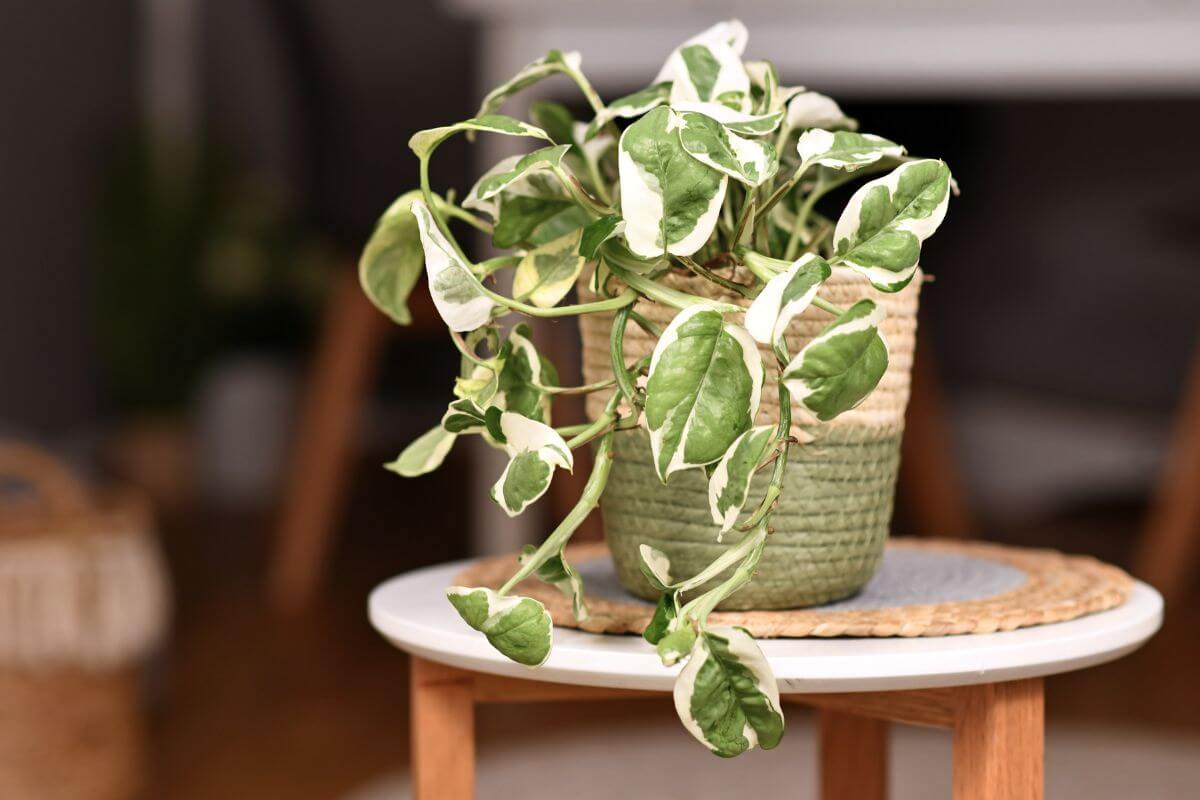
In the language of social media, any plant that has a name like the NJoy Pothos is most certainly intriguing. This variety of Epipremnum aureum is a beauty with smaller-sized foliage spotted with green and white.
There are a number of name variations, but it’s all the same pothos cultivar: NJoy Pothos, N-Joy Pothos, N’Joy Pothos, and Pothos N’Joy.
The common name given to most pothos is “Devil’s Ivy” and most pothos varieties boast very little resemblance to any type of ivy. The exception to this may very well be the NJoy thanks to green leaves with white edging.
No matter how you prefer to spell it, this is a hardy plant with irregular-shaped leaves that is terrific when cultivated as a bushy tabletop plant. Due to its smaller size, it is a great choice for cultivation in terrariums.
The Epipremnum aureum is a native of the South Pacific islands, but the NJoy cultivar was born in 2002 due to the mutation of a Marble Queen Pothos that occurred naturally.
The same breeder of the Manjula Pothos, Dr. Ashish Hansoti, also brought the NJoy Pothos to the world’s attention.
To look at this plant, it may appear odd because the foliage is smaller with irregular shapes and a unique kind of variegation. At first glance, they don’t appear related, but they are.
NJoy Pothos Care Guide
The natural habitat of the NJoy is not outdoors, but inside a greenhouse in India. So, any kind of natural habitat that we attempt to replicate will be connected to that environment.
The NJoy, like the mother plant Marble Queen, is a rapid grower in the right conditions. Its growing habits are, however, more compact because there are shorter spaces between one leaf node and the next.
This allows the NJoy to have a much fuller and bushier appearance, with much less tendency to become leggy. While it does well as a hanging plant, it can climb poles and trellises or just look great as a tabletop plant.
Soil for the NJoy Pothos
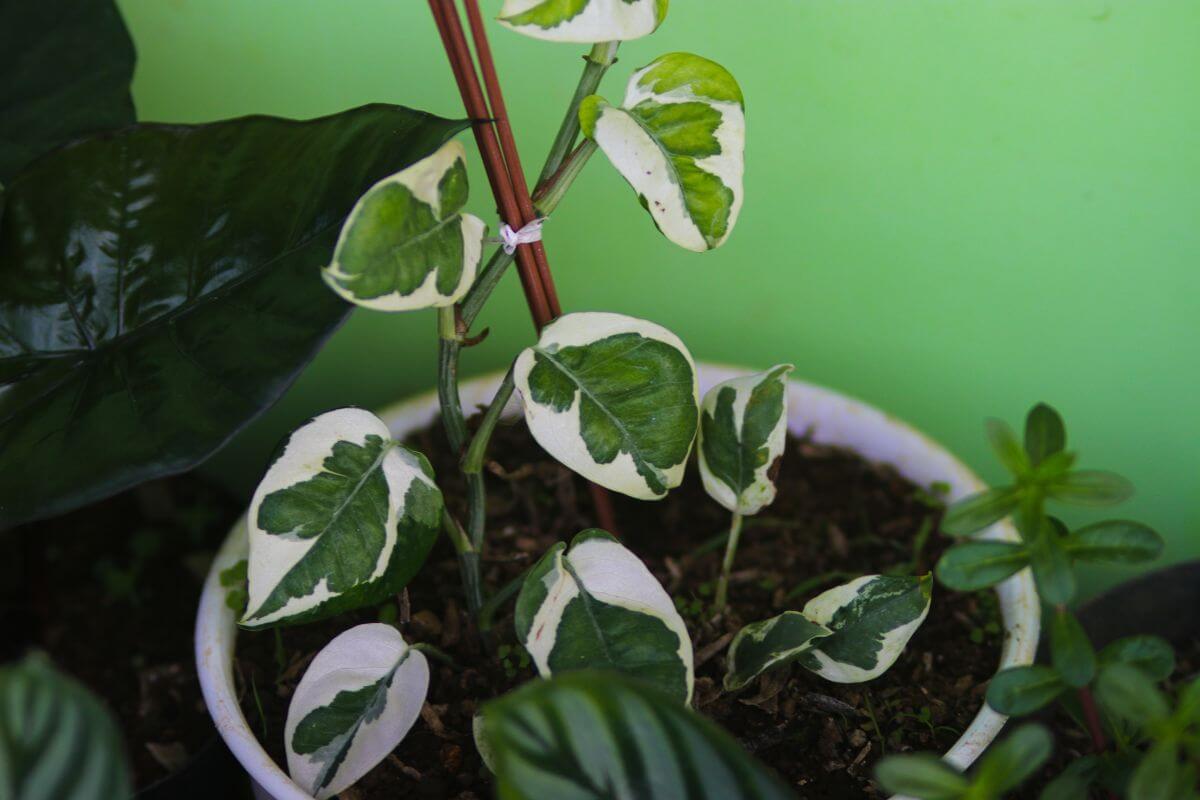
Any good quality, well-draining potting soil will do well, but you can also acquire a specific aroid plant mix. Adding one-third perlite, coco coir, or orchid bark will help ensure drainage.
Keep the soil moist, but it won’t like wet soil. A good pot with drainage holes will be important for the excess water to drain out.
Temperature for the NJoy Pothos
The NJoy will grow well in temperature range that falls between 55° to 95° Fahrenheit, so it won’t be difficult to please it with an average home temperature.
Light for the NJoy Pothos
As with most pothos, bright indirect light is the rule for the NJoy Pothos.
If your windows are south-facing or very sunny, locate your plant several feet from the window to avoid scorching leaves from the direct light.
But it can also depend on the climate you live in. If you reside in a location that is not particularly hot, a south-facing window may be alright.
Pothos is known for adapting to most lighting conditions, from low light to bright light. If you want to give your NJoy some direct light, consider the early morning hours only.
The brighter the indirect light you give your plant, it will grow more variegated leaves. Not enought light will translate into slow, stunted growth and a bit less variegation.
If your home does not receive a great amount of light, you can always use a grow light.
Water for the NJoy Pothos
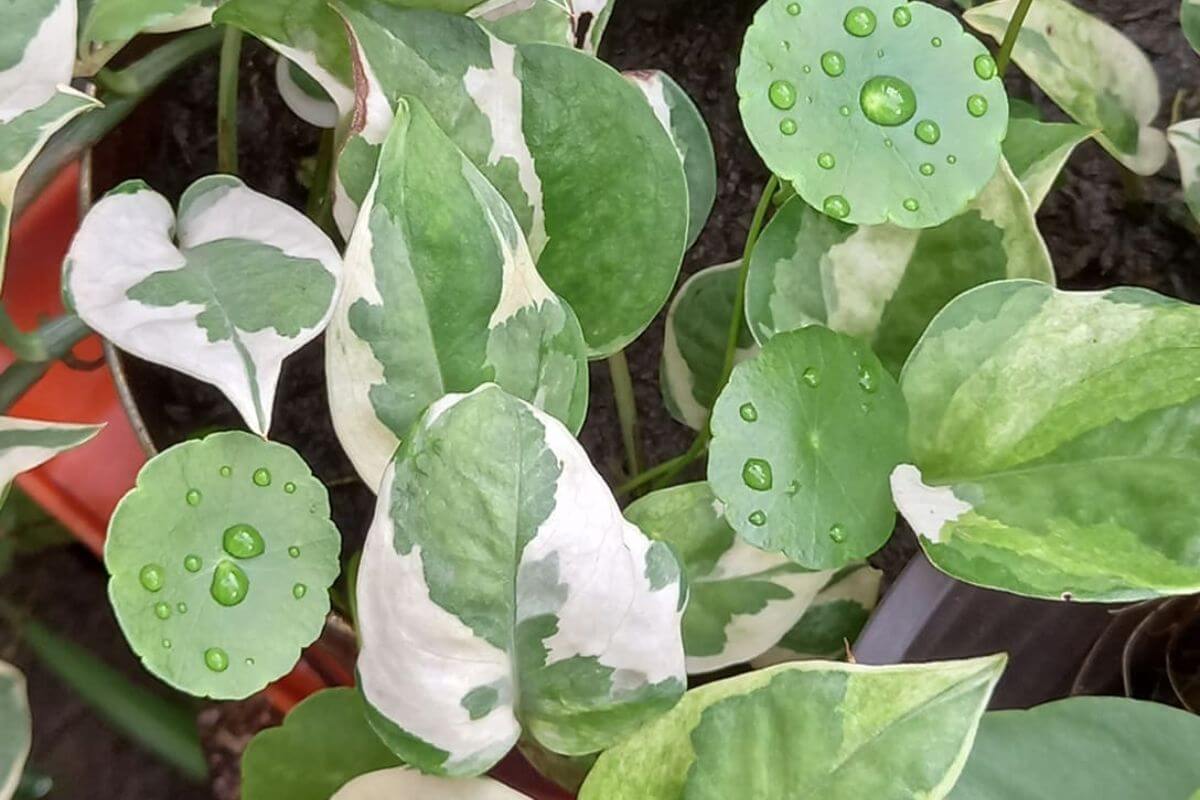
The NJoy enjoys moisture, but like the pothos genus, it is forgiving if you forget to water it, as long as forgetfulness doesn’t become a habit. When the soil bed is dry to your touch, it’s time for a drink.
To water, soaking your NJoy in the sink or the bathtub is a good idea. Run the tap for about ten seconds and then leave the plant in the sink until it drains completely.
The container should have sufficient drainage holes, and a clay terracotta pot can help dissipate excess moisture.
If you are thinking of using a terrarium for cultivation, make sure there is a layer of material, pebbles, perlite, or similar, to ensure proper drainage and avoid the risk of root rot. Watering should be reduced in winter.
Humidity for the NJoy Pothos
Regardless of its birthdate in 2002, this plant is genetically a tropical plant, so the more humidity, the better.
A good humidity level is one between 60 and 90%.
This is a lovely plant if you want to add to your bathroom décor. Kill two birds with one stone if the NJoy is placed there because the bathroom offers higher humidity from showers and baths.
To increase home or office humidity for houseplants, use a humidifier or a pebble tray. You can also group your houseplants together to increase humidity in a specific area of your home.
Fertilizer for the NJoy Pothos
As a light feeder, it does not really require fertilization.
If you want to feed it to ensure it receives proper nutrients for growth rate, a diluted houseplant fertilizer twice yearly should be sufficient.
Repotting the NJoy Pothos
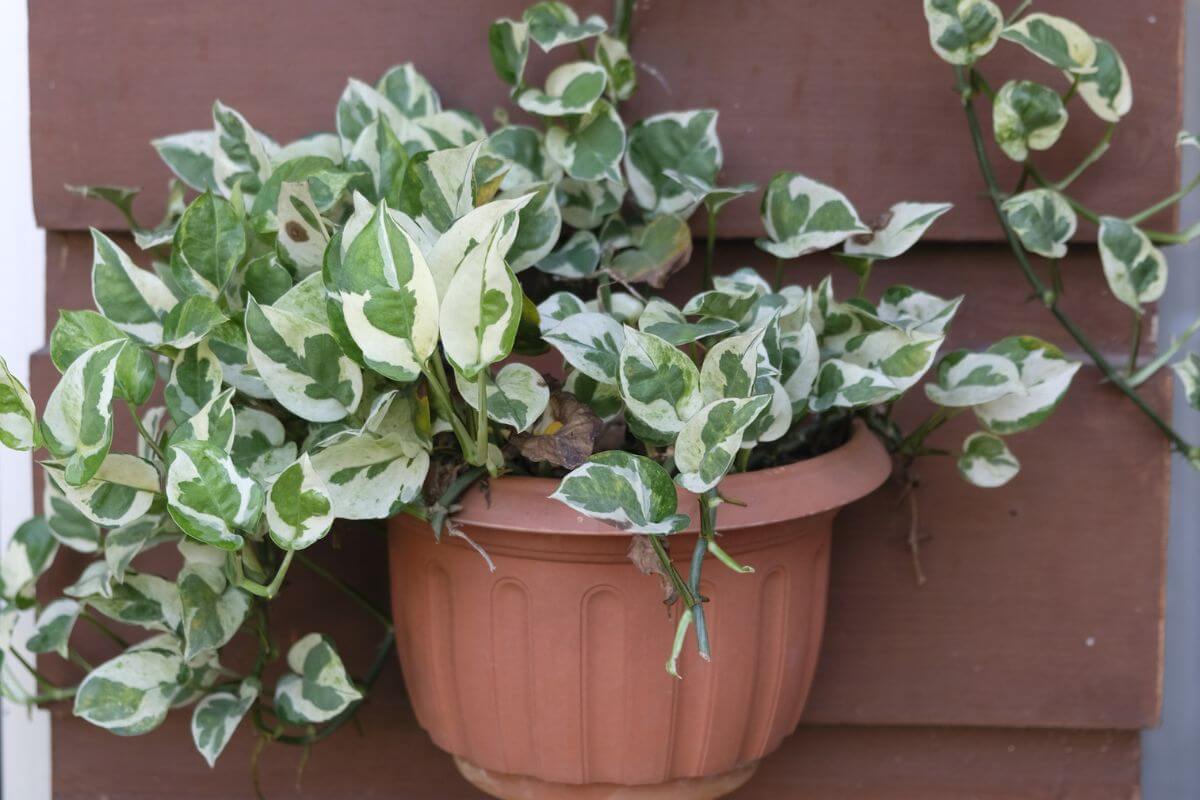
Repot your NJoy when the plant becomes rootbound. Watch for roots peeking out of drainage holes, soil surface, or general suffering on the part of your plant.
Choose a pot one size larger and add fresh potting soil. Be sure to give it lots of indirect natural light if you can to get it grow quicker.
Pruning the NJoy Pothos
Pruning is necessary only if your NJoy appears a bit leggy to you, or if you wish to keep it in a preferred shape.
Propagating the NJoy Pothos
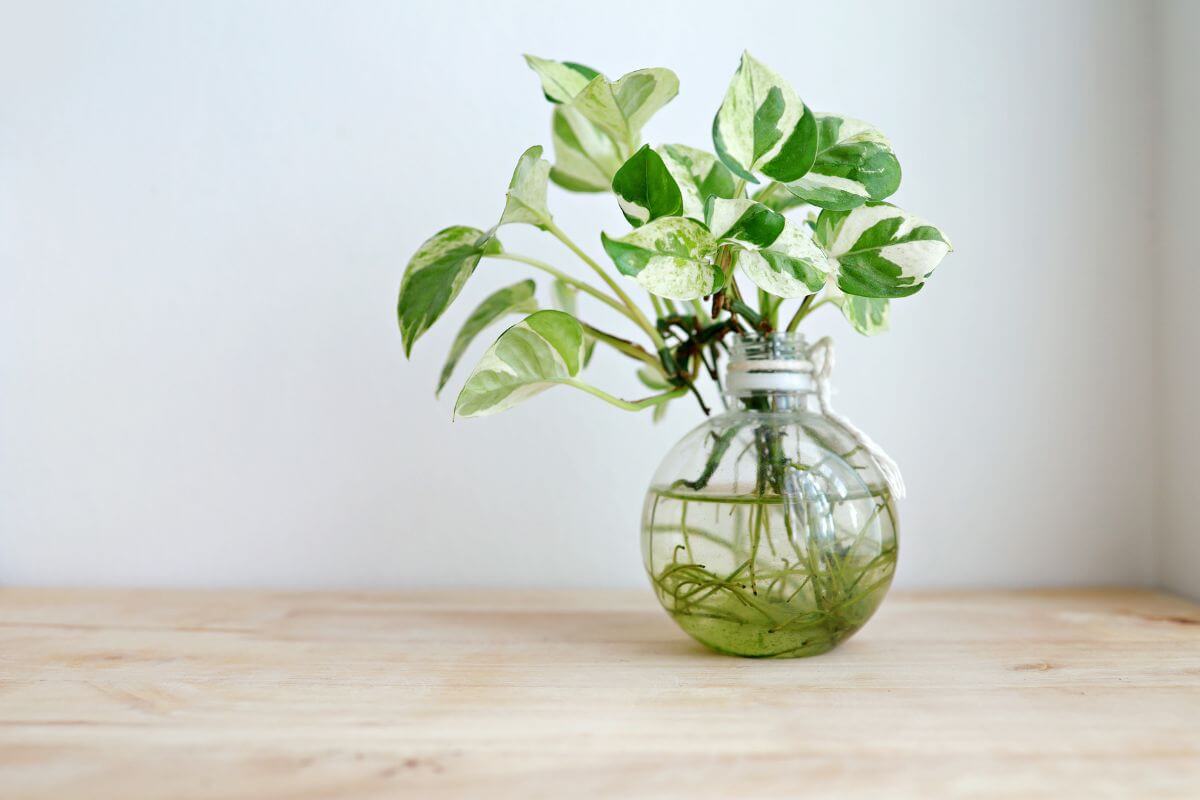
As with other pothos varieties, the NJoy is easily propagated with stem cuttings.
To propagate the Pothos NJoy, follow these steps:
- Snip a length of vine between four and six inches below a leaf node.
- Remove the lower leaves and place the cutting in a jar of water.
- The node should be submerged, but its leaves should remain above the water.
- In about a month, the pothos cuttings in water should form roots, and you can transplant them to potting soil. Remember to change the water in the jar weekly while waiting for root growth.
NJoy Pothos Toxicity and Pets
Like other pothos species, the NJoy Pothos is toxic to pets and humans.
Symptoms from ingestion will include swelling, drooling, vomiting and even death if ingested in substantial amounts.
Be sure to keep the NJoy plants in an area that’s away from plants and small children.
If ingestion does occur, contact poison control or your veterinarian immediately.
NJoy Pothos Problems, Pests, and Diseases
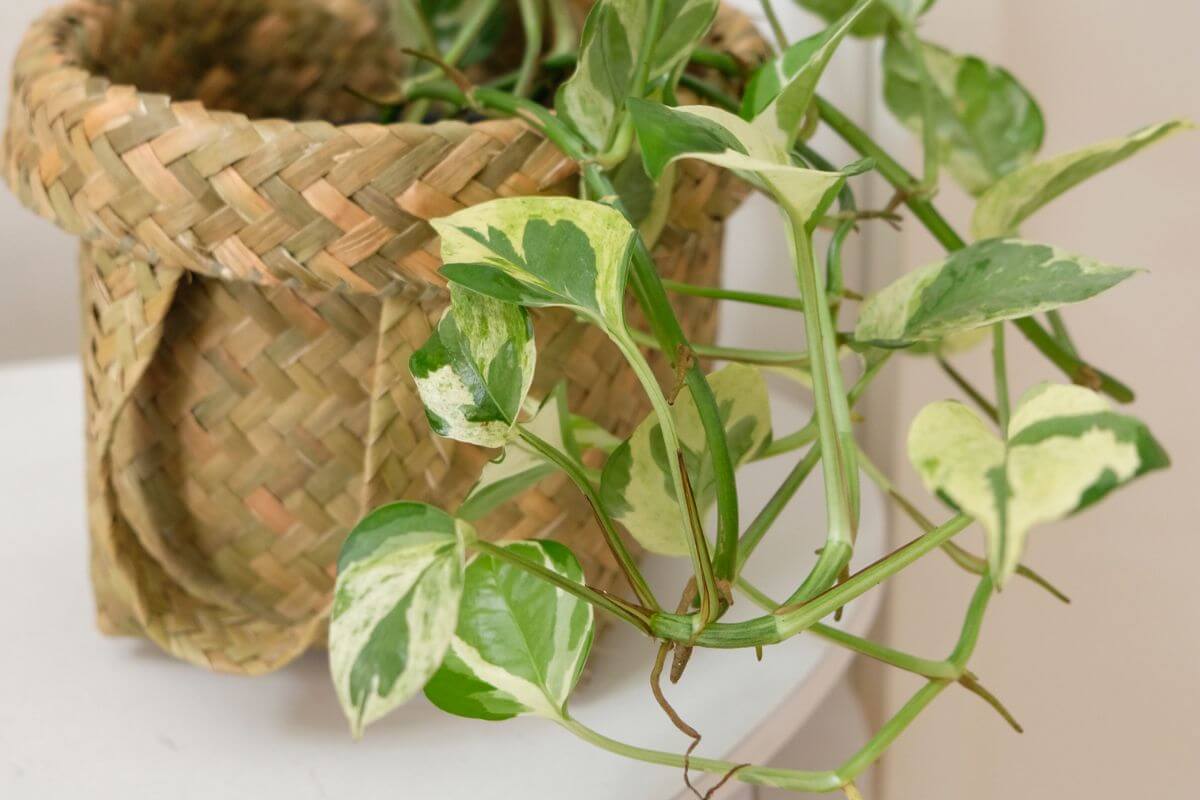
NJoys have most of the the same problems as all houseplants.
Yellow leaves can signify any number of problems, including natural aging and dying. Often, it is a sign of overwatering and root rot. When watering, be sure the extra water drains and only leaves moist soil.
Brown leaves can indicate underwatering or excessive exposure to direct sunlight. It can also be a lack of humidity or too much fertilizer if you have decided to feed it.
Wilting and drooping leaves indicate the plant is underwatered.
Pests to watch out for include aphids and mealybugs, but scale insects and whiteflies are also a threat. Insecticidal soap or neem oil are the organic remedies of choice.
Wiping your NJoy leaves monthly with neem oil will help prevent pest infestations, while also removing dust.
NJoy Pothos Final Thoughts
All in all, the NJoy Pothos is a very easy-to-care-for houseplant that requires little maintenance. If you’re looking for a low maintenance vining plant, look no further than the NJoy Pothos.
For more grow guides for various pothos cultivars, check these out:
NJoy Pothos FAQs
How do you care for the NJoy pothos?
The NJoy pothos need to be watered regularly, and they should be kept away from direct sunlight. They also like bright light, so place them near a window. If you are planning to move them outside, keep them in a cool area until they acclimate to outdoor temperatures.
Does the NJoy pothos grow fast?
The NJoy pothos grows quickly, but it needs a lot of indirect light and water. If you want to plant them indoors be sure it gets enough light for photosynthesis to happen regularly. They also need well-draining potting soil mix for healthy growth.
Why are the NJoy Pothos leaves drooping?
The most common reason that NJoy Pothos leaves are drooping is because of underwatering. The plant leaves are not getting enough nutrients to stay strong, which causes the leaves to wilt. To avoid this problem, make sure to keep the soil moist.
Why are the NJoy Pothos leaves turning brown?
The NJoy Pothos leaves can turn brown for a number of reasons. Overwatering, too much direct sunlight, a lack of humidity, and too much fertilizer can leave to brown leaves and brown leaf tips.
Why are the NJoy Pothos leaves turning yellow?
The NJoy Pothos leaves turning yellow is most often caused by overwatering. Be sure the pot’s drainage holes are not clogged and excess water is able to drain out through them. Other reasons for yellow leaves could be from root rot, natural aging, and the plant is dying.
Why are the NJoy Pothos leaves small?
The NJoy Pothos leaves can grow small if there isn’t enough sunlight, water, or fertilizer available. If there isn’t enough available natural light at home, you may want to consider using artificial lighting or fertilizers to help keep them healthy.


